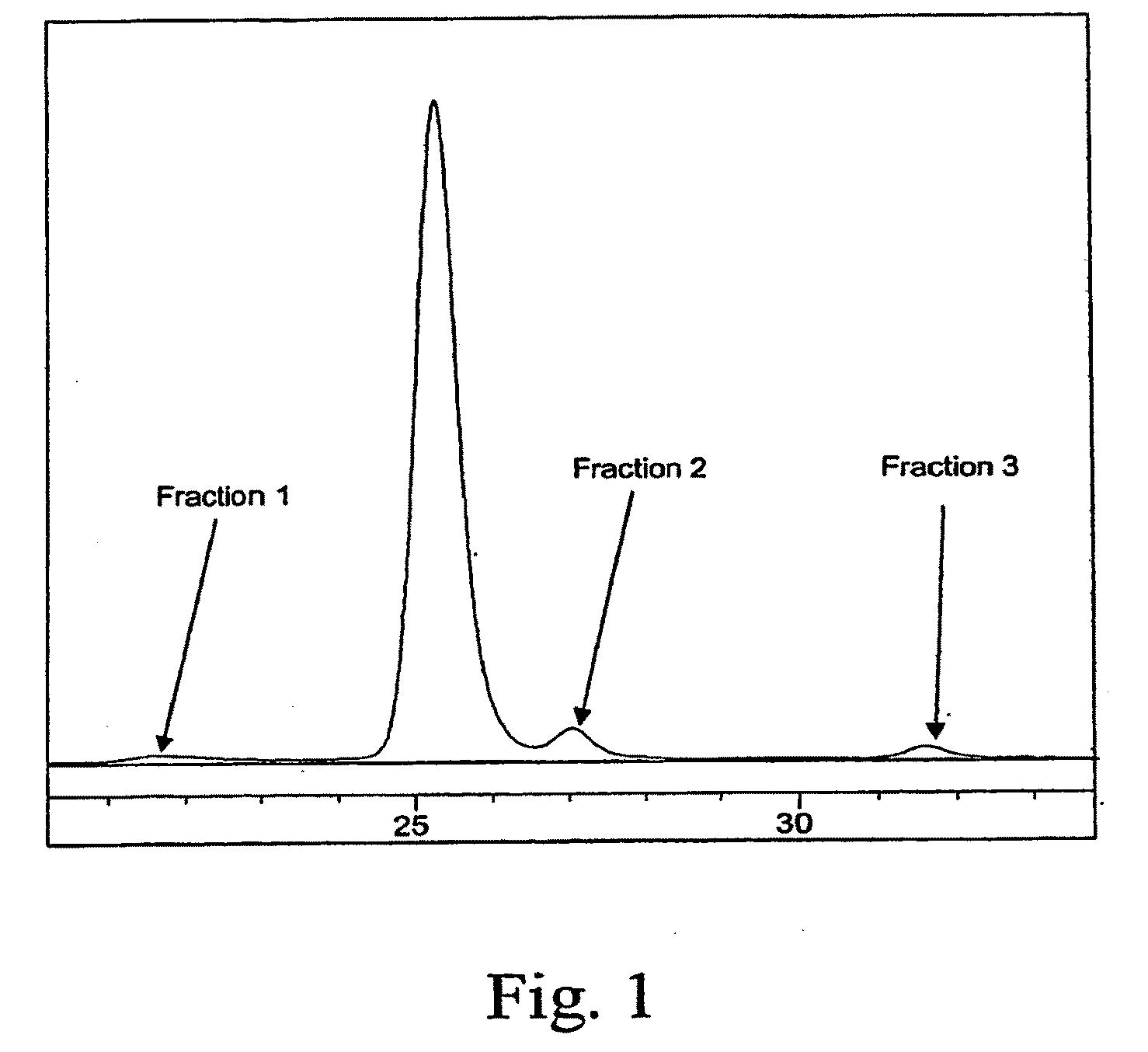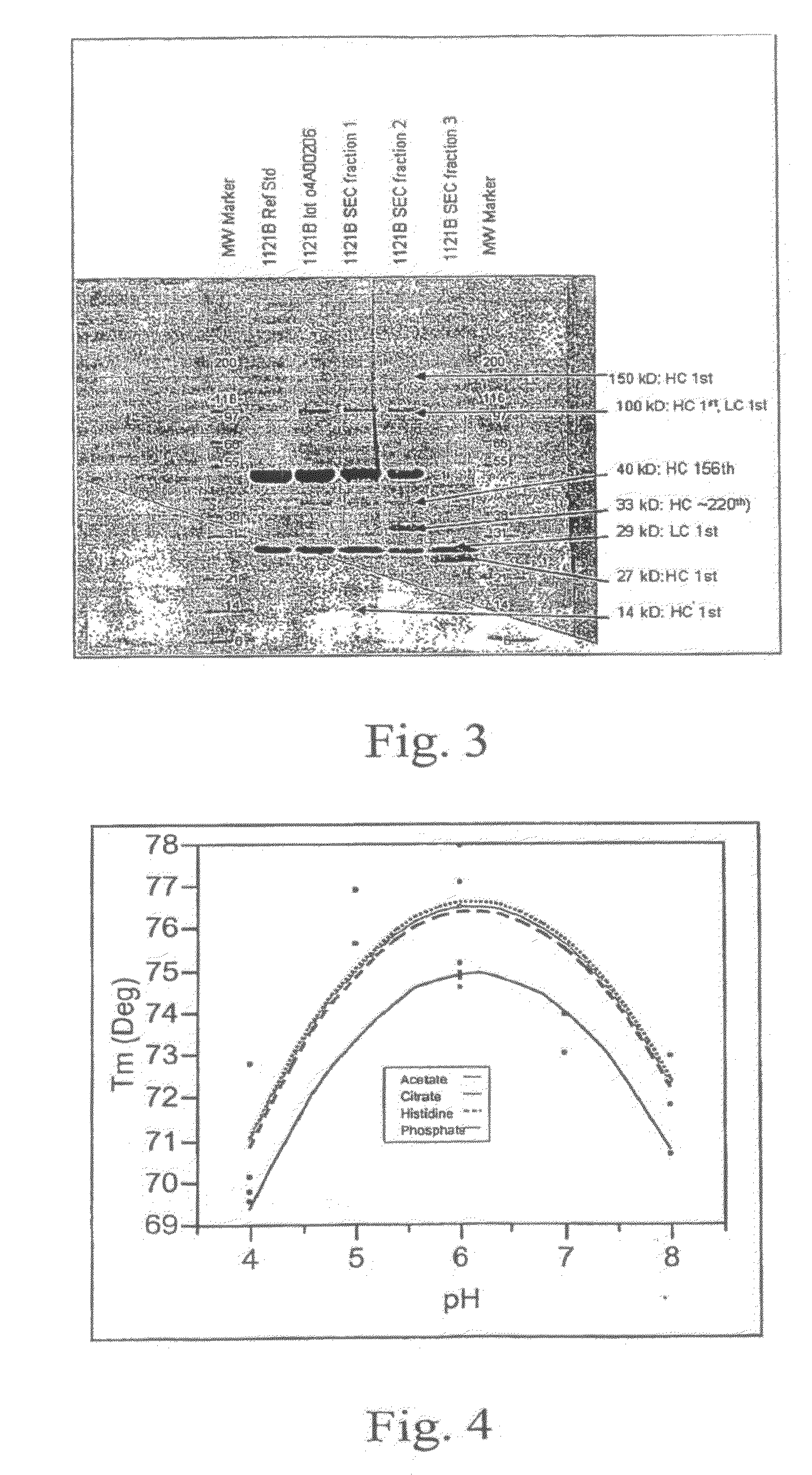Antibody Formulation
a formulation and antibody technology, applied in the field of formulations and methods for the stabilization of antibodies, can solve the problems of proneness of antibodies in liquid formulations, and achieve the effect of inhibiting vegfr activity
- Summary
- Abstract
- Description
- Claims
- Application Information
AI Technical Summary
Benefits of technology
Problems solved by technology
Method used
Image
Examples
example 1
Fragmentation of Anti-VEGFR-2 Antibody, IMC-1121B
[0088]IMC-1211B at 5 mg / mL in phosphate-buffered saline (PBS) was incubated at 40° C. for 3 months. Following this incubation, SEC-HPLC and N-terminal sequencing were used to analyze the degradation products. The SEC-HPLC chromatogram of degraded IMC-1121B in PBS is shown in FIG. 1. The degraded product has two degradent peaks (fractions 2 and 3) in addition to aggregate (fraction 1) and monomer peaks. The fractions were collected using a fraction collector for N-terminal sequence analysis. The cDNA sequence for IMC-1121B heavy chain is shown in FIG. 2. Signal sequence, variable regions and constant regions are shown with underlined, double-underlined and plain text, respectively. N-terminal sequencing analysis of the degraded sample and fractions 2 and 3 has shown two sites of fragmentation in the heavy chain (grey-highlighted text in FIG. 2). The site at the 156th residue from the N-terminus results in two heavy chain fragments dete...
example 2
Optimization of Buffer Formulation
[0089]The freeze-dried formulation for IMC-1121B was developed in two stages. In the first stage, the solvent buffer was optimized using a design of experiment approach (DOE) with fractional factorial modeling as outlined in Table 1. The factors screened in this optimization process were buffer, pH, salt, amino acids, surfactants sugars, and sugar derivatives. Solvent optimization was performed at a 1121B concentration of 5 mg / mL. Controlled agitation at 300 rpm at room temperature was used to test mechanical stability. Thermal stability was tested using DSC and accelerated temperatures. The DOE predictions were confirmed using traditional one-factor-at-a-time methodology. Linear regression analysis was used to determine the significance of the results.
TABLE 1Design of experiment (DOE) matrixNaClAsparticLactobionicTweenGlycineArginineMannitolSucroseTrehaloseBuffer typepH(mM)acid (%)acid (%)80 (%)(%)(%)(%)(%)(%)Citrate6150000.522200Citrate400.5002200...
example 3
Comparison of IMC-1121B Stability in PBS and 10 mM Histidine Buffer (pH 6.0) Formulations
[0094]DOE screening studies predicted that the IMC-1121B antibody has significantly better stability in a 101 mM histidine buffer (pH 6.0) formulation than in PBS. In this study, the stability of IMC-1121B at 5 mg / mL concentration in 10 mM histidine pH 6.0 and PBS was examined by various techniques to confirm the DOE prediction.
[0095]Differential scanning calorimetry (DSC) study: Thermal stability of IMC-1121B in PBS and 10 mM histidine buffer (pH 6.0) formulations were examined according to the procedure described in Methods. The melting temperatures for main transition were 70.0 and 76.6° C. for IMC-1121B in PBS and 10 mM histidine buffer (pH 6.0), respectively.
[0096]Real-time accelerated temperature stability at 40° C. and room temperature: The IMC-1121B at 5 mg / mL was incubated at 40° C. and room temperature (RT) for up to 150 days in PBS and 10 mM histidine buffer (pH 6.0) formulations. Fol...
PUM
| Property | Measurement | Unit |
|---|---|---|
| Concentration | aaaaa | aaaaa |
| Concentration | aaaaa | aaaaa |
| Molar density | aaaaa | aaaaa |
Abstract
Description
Claims
Application Information
 Login to View More
Login to View More - R&D
- Intellectual Property
- Life Sciences
- Materials
- Tech Scout
- Unparalleled Data Quality
- Higher Quality Content
- 60% Fewer Hallucinations
Browse by: Latest US Patents, China's latest patents, Technical Efficacy Thesaurus, Application Domain, Technology Topic, Popular Technical Reports.
© 2025 PatSnap. All rights reserved.Legal|Privacy policy|Modern Slavery Act Transparency Statement|Sitemap|About US| Contact US: help@patsnap.com



